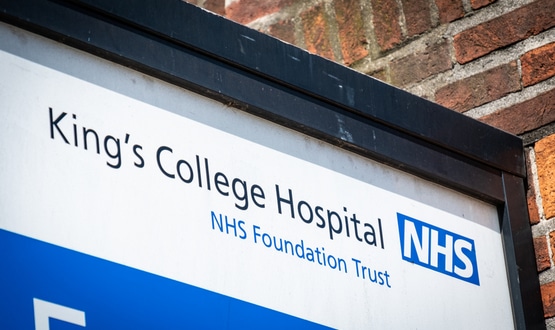Predictions for the year ahead: healthcare IT suppliers on 2017
- 1 January 2017

If 2016 was a year of changing faces at the top of NHS IT, and of changing plans for digitisation – with the arrival of sustainability and transformation plans and digital exemplars – then 2017 should, in theory, be the year when those changes lead to real progress. In the first piece of a two part look ahead to 2017, Digital Health News asks some leading healthcare IT suppliers for their predictions for the year to come.
On STPs and global digital exemplars

Emil Peters, vice president and managing director of Europe and Latin America, Cerner
Global digital exemplars are a big focus for the NHS, and obviously for suppliers. By the end of 2017, exemplars should be making a meaningful difference to how health and care economies work, and not just to the chosen trusts.
I know there has been some criticism about the number and acute focus of the exemplars, but this will not just be about developing those trusts’ capabilities, but improvement that spreads across boundaries.
This can happen in a few ways. Firstly, some exemplar investment will go into interoperability, improving access to acute information for services. For instance, a GP could get access to more acute patient information from an exemplar trust using Cerner, but through their Emis system.
Secondly it could happen through the sustainability and transformation plans or other collaboration projects between neighbours. I am already hearing about other NHS organisations interested in sharing a single instance electronic patient record, such as what is proposed between Chelsea and Westminster NHS Foundation Trust and Imperial College Healthcare NHS Trust.
This needs strong clinical input and integration to work, but exemplars can be an investment vehicle for spreading systems like this, and not just Cerner. I think we will see more of these arrangements in 2017.
Thirdly, global exemplars can provide a blueprint for other trusts to follow, and this will start happening in 2017. There’s been some talk about ‘fast followers’ – trusts that use the exemplars' blueprint to fast track digital advancement. This could happen both regionally, within an STP footprint, but also based on exemplars that are successful from around the country.
I use the term 'blueprint' with a caution because we can't just rip out existing systems and replace them with what worked at an exemplar site. The National Programme of IT has shown us what happens if you do that. It needs to be nuanced, with the needs in each community respected.

Natalie Chishick, policy and communications director, IMS MAXIMS
STPs' status as the ‘only game in town’ will be cemented in 2017. From the spring, we will start to see which STPs have been prioritised for funding. It’s not yet clear if those with a significant focus on technology will be at the front of the queue.
What is more certain is that digital planning will have a new focus, with greater emphasis on area-wide requirements, rather than any single enterprise. Among the requirements for STPs and their associated local digital roadmaps will be the ability for health and social care organisations to share information to enable care across the continuum.
Interoperability, now more than ever, will be paramount. Software suppliers are taking their share of responsibility by developing open APIs and promoting open standards. The INTEROPen group is set to grow in 2017, with membership open to all.
Global digital exemplars will influence the direction of travel for STPs’ digital maturity aspirations in the acute sector. Despite exemplar funding, finite investment in IT will continue to be a major consideration for many NHS trusts. They will look for flexible and creative solutions to finance and deliver systems which can scale to STP requirements.

Philippe Houssiau, vice president, UK Healthcare and Life Sciences, CSC
The Wachter Review, combined with the advent of STPs, will make for a recalibration of healthcare IT in 2017. We see four key themes.
Firstly, digital transformation is becoming completely ingrained into the texture of healthcare delivery. We’ll see a continuing shift from deploying software products to enabling systemic change with digital services. The focus will be on improving clinical outcomes, personalising health services by better understanding and handling variations in care, and streamlining operational activity.
Secondly, the thrust towards interoperability and open architectures will accelerate, and we will see an increasingly widespread push to introduce community-wide health records. The aim will be to achieve better end-to-end integration of health and care services across communities, which will be defined by STP ‘footprints’.
Thirdly, a new layer of analytical tools will start to be layered on top of community-wide health records. This will provide healthcare leaders and policy makers with contextual insights, built on the back of population and patient data, and used to drive improvements in service efficiency and clinical effectiveness.
Finally, we will see the recognition that NHS IT is built on under-invested infrastructure. With as many as 90% of NHS trusts still using Microsoft Windows XP, and almost weekly reports of major hardware failures. It’s time for healthcare CIOs to put in place robust infrastructure strategies addressing cost, efficiency, resilience and security.
On big data and sharing

Mark Palmer, UK country manager, InterSystems
2017 is the year we are going to start really unlocking the power of NHS data. Getting the benefit from data is exponentially related to how much data you have. The NHS has a huge wealth of data that it can release, but now it is locked in silos.
The Department of Health and NHS Digital spend a fortune collecting endless information, but in 2017 we are going to see how this data can be used to improve care. The time is right. We have the open standards, the ability to process data, and the means to join up systems at scale that just weren’t there, say, 15 years ago.
The technology is there to do this, but there are some very complex consenting models that need to be navigated in the whole debate about who owns the data. These issues can get in the way, but NHS personnel need to be brave and say we are going to do this, to improve care. Up until now people have been cautious, though the building momentum should overcome these barriers to success.
I think we are going to see more chief data officers in NHS organisations, curating the data, taking responsibility for data quality. While it is fraught with risk, we are going to see more of this data anonymised and distributed. You just have to be careful and follow the right process to unlock that value.
While a lot of data is being gathered centrally I think using big data to improve care will grow regionally next year. It’s got to be bottom up, connecting operational systems across care settings as has already started in places like Merseyside and Lincolnshire.

John Connolly, clinical director, TPP
The start of 2017 will see the NHS continue to face enormous pressure to achieve financial sustainability whilst transforming services to make them safer and more patient-centred. Technology-led innovations will, again, take centre stage as the principal mechanism to achieve the gains in productivity and quality which are desperately needed.
Citizens, supported in every other aspect of their lives by high-tech solutions, will rightly expect that their carers will have instant access to rich, electronic clinical data to be used for their direct care. With this, front-line clinical teams will be able to short-circuit traditional, arduous assessment processes by re-using detailed and structured information, with patient consent. Carers will increase their use of electronic interactions with patients and create virtual teams to provide holistic and efficient care.
We must encourage the pace of interoperability projects and promote pragmatic leadership in the search for a nationally agreed model for making data visible across organisational boundaries (for direct patient care). Only by doing this will progress be made in developing new care models, place-based commissioning and empowering patients to be more involved in their care. Interoperability itself will be enhanced, as diverse systems make progress towards the adoption of a durable, common, coding scheme using SNOMED CT.
On clinical input and usability

Donald Kennedy, managing director, Patientrack
2017 will be a year for listening to frontline demands and responding fast with digital solutions. Clinical engagement has long been an aspiration in digital progress, but throughout 2016 we have seen an explosion of tangible examples of using technology to respond to actual clinical needs.
From functionality that allows healthcare professionals to predict, identify and respond to serious conditions including sepsis and acute kidney injury to providing the means to spot signs of malnutrition, frontline staff have made their voices heard and have led the development of technology.
2017 must be the year when technology suppliers deliver more with the grassroots, engage beyond the purse strings at the board level and act to make their innovations meaningful to the people who use the information to improve patient care.

Shaun O’Hanlon, medical director, Emis Health
The power and interest of the clinician is going to have a much bigger influence over what IT systems are purchased in 2017.
There are a lot of systems now that require two or three days' training to use, but you don’t need an instruction manual to use Uber, and I think that will increasingly become the expectation for clinical systems in 2017. The industry needs to think about usability as much as it thinks about security, interoperability, and scalability.
In the past, systems have been procured on what they can do, so there has been a tendency from suppliers to say we can do more. That is changing, with usability takes precedence over functionality.
The key change in the dynamic has been the role of chief clinical information officer. IT systems have traditionally been picked by the chief information officer or IT director, but clinicians are now much more involved.
The barriers to making this happen are inertia from suppliers – because it does require investment – and understanding what users need; which isn’t always the same as what they want. It requires deep engagement, and I think we are going to systems change much more rapidly, in small steps, in response to clinical feedback. Unless existing suppliers rise to that challenge, they will be under threat from new people coming in.
On pathology

Jane Rendall, managing director UK and Ireland, Sectra
I believe 2017 will see more tangible movements towards the digitisation of pathology with vanguard sites leading the way to adoption. Considering the report recently published by Cancer Research UK in which a move to digital is deemed necessary to improve our cancer services, I believe we will start seeing more successful validations of the technology and applications for funding in trusts. However, with lack of central funding available, investment is still proving to be a challenge for many.
2017 will see a shift in buying drivers, with risk mitigation, workload balancing and building a single patient record moving to the top of the buying criteria.
This year’s Digital Pathology Congress in London showed this change in mentality very clearly. With past discussions at the congress focusing on how digital pathology would allow for the use of image analysis to further advance research and improve teaching, conversations have since shifted to the real benefits of this technology in primary healthcare and how it can reduce risk and improve the quality of the care delivered.
Tomorrow we will run our second piece on the year ahead, asking UK digital health leaders for their 2017 predictions.




